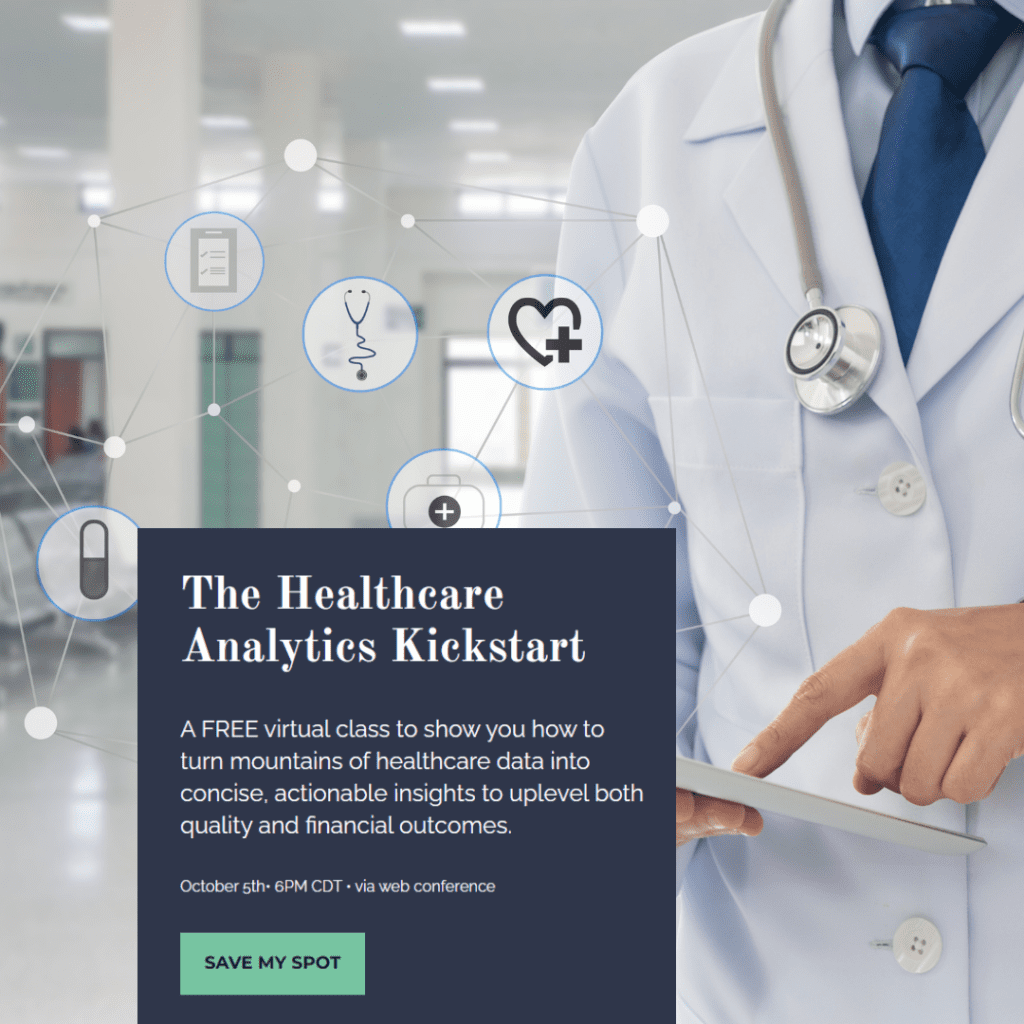Maybe you’ve heard the title Healthcare Data Analyst and wondered what they do. It’s a little obscure. I mean, of course, they work with healthcare data…but what exactly do they do with it? Answer: EVERYTHING!
As we’ve talked about in other posts, data is everywhere and in every industry. That is especially true in healthcare. A person can get lost data mining around in a set of healthcare data!
Most reports that a Healthcare Data Analyst prepares will fall into one of two categories:
- Financial Analysis, or
- Clinical Analysis
Some reports will fall into both categories.
For this post, I’ll concentrate on work a Healthcare Data Analyst does inside a hospital. This is by no means an exhaustive list, but here are some examples of both categories of analysis.
Financial Analysis

Hospitals concentrate heavily on providing high-quality patient care and that is priority 1, but at the end of the day a hospital is a business. And, just like all other businesses, hospitals have to remain financially stable in order to continue to keep the doors open and offer care to patients.
One of the most critical areas of the analyst’s work is monitoring the financial outcomes in a myriad of ways. Here are some examples of financially-based analytics:
LENGTH-OF-STAY REPORTING
Length-of-stay (LOS) refers to the number of days a patient is in the hospital. If a patient is in the hospital for 5 days, that’s reported as a “5 day LOS”.
People that haven’t worked in healthcare don’t realize that the hospitals don’t necessarily make money for each day a patient is in the hospital. Shocking, right?
Here’s how that works…insurance companies have contracts with the hospitals that state the amount (reimbursement) they will pay for particular procedures or diagnoses. (And, it’s many times not even close to what it actually costs to do the procedures, but that’s a story for another post!)
Let’s say a patient comes in to have a baby. The insurance company has likely contracted with the hospital to pay for an expected two-day LOS for the patient and a reimbursement of around $1,800.
Now, if that patient has issues that require a longer stay, say a total of four days, the hospital still receives payment of only $1,800. So, it’s obviously critical that hospitals monitor their average length-of-stay (ALOS) for all the many patient populations in order to maintain a positive bottom line.
Side note: ALOS is used in 90% of all hospital analytics in one way or another.
REIMBURSEMENT VS. COST REPORTING
Getting back to the reimbursement from insurance companies, these payments are compared in many different ways. We can look at a comparison of reimbursements by insurance company for a particular patient population.
An example here would be on a patient population having total knee replacement surgeries during a six month period. We would calculate the average reimbursement (payment) from each insurance company and observe the differences. There are wide variations between all the different groups of payers.
We could take this analysis further by comparing the average reimbursements to the average cost of the population.
When we talk about cost attributed to the patient visits, we’re looking at what the labor and supplies actually cost the hospital to perform the surgery and medicate/monitor the patient for the entire hospital stay.
Going back to our total knee replacement population, we could do an analysis to study the differences between the average reimbursement by insurance company and the average cost for that company’s cases.
We also (often) look at the average case costs by physician to see if there are physicians who may have utilization issues. This sort of analysis can open up lots of additional avenues to study.
Clinical Analysis

On the clinical side, there’s never an end to things to study as well. Here are just a few examples of clinical analysis work that a Healthcare Data Analyst would do:
COMPLICATION STUDIES
Everyone is aware that complications can occur during procedures, surgeries, or for other reasons while patients are in the hospital. It’s extremely important for hospitals to study all complications and look for root causes of each. Analysts also study complications over a period of time or in a population of patients to draw conclusions across a wide set of data.
Complication rates are analyzed at the physician level as well in order to identify physicians noted to have higher rates than the peer group. A continued study into the patient population for any physicians identified would be the next step in the analysis.
READMISSION STUDIES
There are all kinds of rules around patients readmitting to the hospital. I’ll cover them all in another post, but for now, understand that a “readmission” is a patient that had a stay in the hospital, discharged and then came back to the hospital for another admission within a span of days. Typically, hospitals concentrate on any readmission occurring within 30 days of discharge, although we do sometimes look out through a 90 day window of time.
It’s important to monitor readmissions from a clinical standpoint to evaluate for things like:
- was the patient possibly sent home too quickly during the initial visit?
- was there a complication that brought them back into the hospital?
- is there an infection in play that is a result from the prior admission?
- are there readmission trends by physician?
It’s also important to monitor readmissions from a financial standpoint because many times the hospital won’t be paid for the readmission visit if it occurs within a certain number of days after the initial discharge.
MORTALITY STUDIES
In the healthcare world, you’ll hear patient deaths referred to as the patient expired or as a mortality.
When reporting deaths in a specific population of patients, it is referred to as a Mortality Rate. Mortality Rate simply reflects the percentage of patients that expired out of the total patient population being studied. There are some other calculations that can be built into this to provide clinical adjustment, but that’s the basic definition.
Just as in the areas of complications and readmissions, these cases are studied at the physician level as well to look for trends.
Other Examples of Analytics Performed

As I mentioned, there are so many different types of reporting that Healthcare Data Analysts do. The important takeaway here is that the analyst is an extremely integral part of the healthcare team. The work of the analyst allows administrators, managers, physicians and clinicians insight into trends that need to be studied further and analysis that determines underlying issues or identifies areas in need of management.
Here’s a look at just a few other examples of questions answered by the data mining and analysis efforts of Healthcare Data Analysts:
- Who are the top 25 patients with repeat visits to the Emergency Department?
- Which zip code are most outpatient visits coming from? (Maybe a good place for a new clinic.)
- Who are the top 10 physicians bringing in the most volume?
- Which service lines have the highest self-pay percentages?
- Which Orthopedic knee implant has the best long-term outcomes for our patients?
- What are the higher-cost physicians doing differently than the lower-cost physicians in specific procedures?
- Where are the LOS issues across the facility when compared to the expected LOS?
And here are a few examples of larger studies that a Healthcare Data Analyst will do:
- Strategy & Business Development Plan that gives an in-depth look at all services provided by the hospital in both inpatient and outpatient settings. The study reflects both financial and clinical outcomes for each service line, highlights observations, and makes recommendations.
- Service Line Growth Study that explores each service line by doing a lookback study to show trends over the past few years and rolls in forecasting data to predict growth of each service line into the future.
- Physician Profiling Study prepares a graphical “report card” on each physician studied and shows at a minimum the physician’s ALOS, average case cost, complication rates, readmission rates and mortality rates – comparing each of these metrics against his/her peers.
I hope this has helped give you a little insight into the amazing work Healthcare Data Analysts do. It’s such an exciting role and one that allows the analyst to really see the inner workings of the hospital.

If you’d like to hear more about the work of a Healthcare Data Analyst and how you can tap into the role, join me for my upcoming, one-hour class “Healthcare Analytics Kickstart” – you can save your seat here.
To digging the data,

If you’d like to learn more about life as a Data Analyst and how to break into this amazing career path, check out my free training – The Making of a Data Analyst.